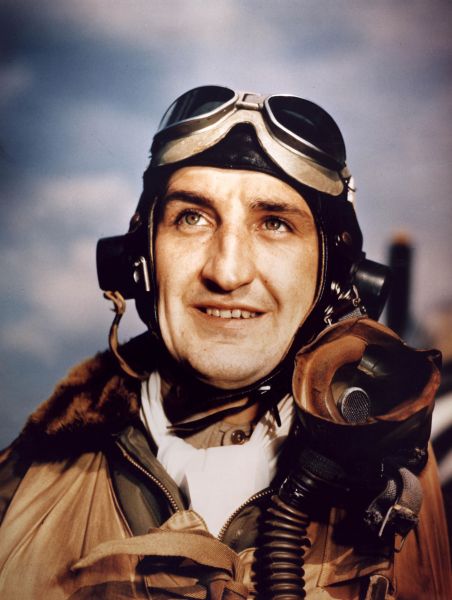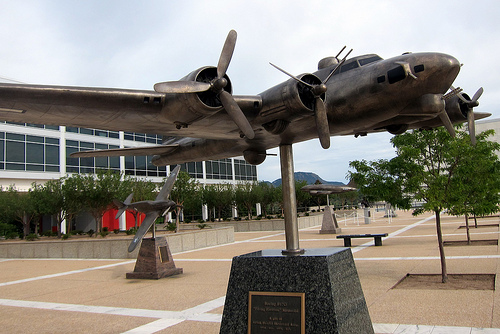Gabreski, Francis Stanley "Gabby"
- Date of birth:
- January 28th, 1919 (Oil City/Pennsylvania, United States of America)
- Date of death:
- January 31st, 2002 (Huntington/New York, United States of America)
- Buried on:
- Calverton National Cemetery
- Nationality:
- American
Biography
Gabreski was born January 28, 1919, from both Polish parents, in Oil City, Pennsylvania, where he grew up, and graduated from Oil City Public High School in 1938. He then entered undergraduate Pre-Medical training at Notre Dame University, remaining until July 1940 when he entered AAF pilot training at Parks Air College, graduating in March 1941, at Maxwell Field, Alabama as a Second Lieutenant.
He was promptly sent to Wheeler Field, Hawaii where, as a member of the 45th Fighter Squadron, 15th Fighter Group, witnessed the Japanese attack on December 7, 1941, and remained a pilot with the 45th until October 1942, when he was transferred to the 8th Fighter Command in the Europe. Soon, in November 1942, he was assigned as Liaison Officer to the Polish Air Force, flying British-built Spitfires on 20 combat missions with the 315th Fighter Squadron.
In February 1943 he was reassigned to the 61st Fighter Squadron, 56th Fighter Group in England, flying the Republic P-47s which served him so well in downing German aircraft. Four months later, in May 1943 he was assigned Command of the 61st Fighter Squadron, which he led until July 20, 1944 - when he was shot down over Germany.
Uninjured, he jumped out of the crashed plane and ran toward deep woods with German soldiers in pursuit. He eluded them for five days, but was finally captured and taken to Stalag Luft I, a permanent prisoner-of-war camp. After the camp was liberated by the Russians in April 1945, Gabreski spent several years in flight testing and in command of fighter units before he succeeded in getting an assignment to Korea.
In July 1951, Gabreski, now a lieutenant colonel, downed his first MiG, flying an F-86 Sabre jet. He did this despite being so unfamiliar with the F-86's controls that he replaced the gun sight with a piece of chewing gum stuck on the windshield. In April 1952, he recorded his fifth kill of the Korean air war, becoming the first and one of few pilots to become aces in two wars. He was credited with a total of 6.5 kills in Korea.
He ended his career as commander of several tactical and air defense wings, his last assignment being commander of the 52nd Fighter Wing at Suffolk County AFB, New York. He retired in November 1967, nearly 27 years and 37.5 destroyed enemy aircraft later, after squeaking through his "elimination flight." At the time he had flown more combat missions than any other American fighter pilot. He received another honor in 1992 when Suffolk County Airport in Westhampton was renamed Gabreski Airport.
Gabreski died of an apparent heart attack in Huntington Hospital, Long Island, N.Y.
Do you have more information about this person? Inform us!
- Period:
- Second World War (1939-1945)
- Rank:
- Major
- Unit:
- 61st Fighter Squadron, 56th Fighter Group, U.S. Army Air Forces
- Awarded on:
- January 27th, 1944
"The President of the United States of America, authorized by Act of Congress, July 9, 1918, takes pleasure in presenting the Silver Star to Major (Air Corps) Francis S. Gabreski (ASN: 0-406132/4761A), United States Army Air Forces, for conspicuous gallantry and intrepidity in action against the enemy while serving with 61st Fighter Squadron, 56th Fighter Group, 8th Air Force, while leading his Squadron on forty fighter sweeps and bomber escort missions over enemy-occupied Europe, during the period 3 May 1943 to 15 December 1943. Major Gabreski was selected to lead his Group on three bomber escort missions and on each occasion furnished excellent support for the bomber formation. As a result of Major Gabreski's gallant leadership and untiring effort in training, the highest type of combat efficiency has been maintained at all times and losses have been held to an absolute minimum. Members of his unit have destroyed 45 enemy aircraft and severely damaged many more. The gallantry, leadership and skill in combat displayed by Major Gabreski have been a constant inspiration to all flying with him and reflect highest credit upon himself and the Armed Forces of the United States."
General Orders No. 22 (January 27th, 1944).
- Period:
- Second World War (1939-1945)
- Rank:
- Lieutenant Colonel
- Unit:
- 61st Fighter Squadron, 56th Fighter Group, U.S. Army Air Forces
- Awarded on:
- April 26th, 1944
"The President of the United States takes pleasure in presenting the Distinguished Service Cross to Francis S. Gabreski (0-406131/4761A), Major (Air Corps), U.S. Army Air Forces, for extraordinary heroism in connection with military operations against an extraordinary heroism in connection with military operations against an armed enemy while serving as Pilot of a P-47 Fighter Airplane in the 61st Fighter Squadron, 56th Fighter Group, EIGHTH Air force, in aerial combat against enemy forces on 26 November 1943, in the European Theater of Operations. On this date Major Gabreski shot down two enemy aircraft, bringing his total to this point in the war to more than 30 victories. Major Gabreski's unquestionable valor in aerial combat is in keeping with the highest traditions of the military service and reflects great credit upon himself, the 8th Air force, and the United States Army Air Forces."
General Orders No. 25 (April 26th, 1944)
- Period:
- Second World War (1939-1945)
- Rank:
- Lieutenant Colonel
- Unit:
- 61st Fighter Squadron, 56th Fighter Group, U.S. Army Air Forces
- Awarded on:
- September 28th, 1944
"The President of the United States of America, authorized by Act of Congress, July 9, 1918, takes pleasure in presenting a Bronze Oak Leaf Cluster in lieu of a Second Award of the Silver Star to Lieutenant Colonel (Air Corps) Francis S. Gabreski (ASN: 0-406132/4761A), United States Army Air Forces, for conspicuous gallantry and intrepidity in action against the enemy while serving with 61st Fighter Squadron, 56th Fighter Group, 8th Air Force, while leading his Squadron on a sweep over Germany in advance of a heavy bombardment mission, on 22 May 1944. Observing sixteen FW-190's taking off from an airdrome, Colonel Gabreski attacked although his flight was out-numbered two-to-one. During the ensuing battle, Colonel Gabreski destroyed two enemy planes and then climbed to 12,000 feet where he was joined by part of his squadron. Twenty more enemy planes were sighted below and without hesitation, Colonel Gabreski made his attack, shooting down one plane out of the formation. Heading home, a lone FW-190 was spotted and Colonel Gabreski was successful in getting several direct hits before the enemy went into a cloud. Colonel Gabreski's dynamic leadership and aggressiveness in the face of overwhelming odds, served as an inspiration to his fellow pilots and resulted in the destruction of three enemy planes and the probably destruction of a fourth. Lieutenant Colonel Gabreski's gallant actions, without regard for his own life, were in keeping with the highest traditions of military service and reflect great credit upon himself, his unit, and the United States Army."
General Orders No. 501 (September 28th, 1944)
- Period:
- Second World War (1939-1945)
- Period:
- Second World War (1939-1945)
Second DFC awarded as a Oak-Leaf cluster for on the ribbon of the first DFC.
- Period:
- Second World War (1939-1945)
Third DFC awarded as second Oak-Leaf cluster for on the ribbon of the first DFC.
- Period:
- Second World War (1939-1945)
Fourth DFC awarded as third Oak-Leaf cluster for on the ribbon of the first DFC.
- Period:
- Second World War (1939-1945)
Fifth DFC awarded as fourth Oak-Leaf cluster for on the ribbon of the first DFC.
- Period:
- Second World War (1939-1945)
Sixth DFC awarded as fifth Oak-Leaf cluster for on the ribbon of the first DFC.
- Period:
- Second World War (1939-1945)
Seventh DFC awarded as sixth Oak-Leaf cluster for on the ribbon of the first DFC.
- Period:
- Second World War (1939-1945)
Eighth DFC awarded as seventh Oak-Leaf cluster for on the ribbon of the first DFC.
- Period:
- Second World War (1939-1945)
Nineth DFC awarded as eighth Oak-Leaf cluster for on the ribbon of the first DFC.
- Period:
- Second World War (1939-1945)
- Period:
- Second World War (1939-1945)
Second AM awarded as a Oak-Leaf cluster for on the ribbon of the first AM.
- Period:
- Second World War (1939-1945)
Third AM awarded as second Oak-Leaf cluster for on the ribbon of the first AM.
- Period:
- Second World War (1939-1945)
Fourth AM awarded as third Oak-Leaf cluster for on the ribbon of the first AM.
- Period:
- Second World War (1939-1945)
Fifth AM awarded as fourth Oak-Leaf cluster for on the ribbon of the first AM.
- Period:
- Second World War (1939-1945)
- Period:
- Second World War (1939-1945)
- Period:
- Second World War (1939-1945)
- Period:
- Second World War (1939-1945)
- Period:
- Second World War (1939-1945)
- Period:
- Second World War (1939-1945)
- Period:
- Second World War (1939-1945)
- Period:
- Second World War (1939-1945)
- Period:
- Second World War (1939-1945)
- Period:
- Second World War (1939-1945)
Sources
- Photo 1: Bill Gonyo
- - William N. Hess, America's top WW II aces in their own words: Eighth Air Force, MBI Publishing Company, ISBN 0-7603-1074-2
- William E. Oliver, The inner seven: the history of seven unique American combat aces of World, Turner Publishing, ISBN 1-56311-504-2
- Home of Heroes
- Acepilots.com
- U.S. Air Force

















